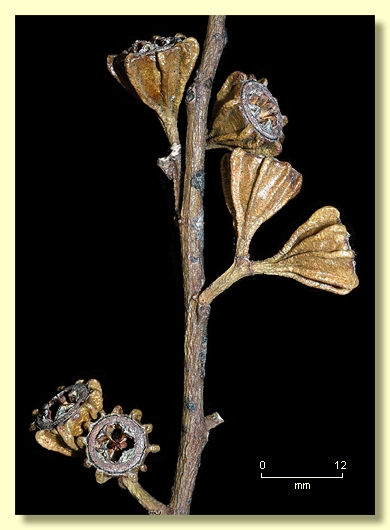Eucalyptus | Symphyomyrtus | Dumaria | Rufispermae
Euclid - Online edition
Eucalyptus frenchiana
Eucalyptus frenchiana D.Nicolle, Nuytsia 19: 92-95 (2009).
T: Western Australia: 6.8 km west of the Coolgardie turnoff towards Hyden on the new Hyden to Norseman road, 32° 03' 19" S, 120° 42' 36" E, 10 November 2000, D. Nicolle 3663 & M.E. French (holo: PERTH; iso: CANB).
Mallet to 12 m tall. Non-lignotuberous.
Bark smooth throughout, grey over fawn to brown and salmon, shedding in long ribbons.
Branchlets have oil glands in the pith.
Juvenile growth (coppice or field seedlings to 50 cm): not seen.
Adult leaves alternate, petioles 0.8-1.9 cm long; blade linear to narrowly lanceolate, (4.6)6–10 cm long, 0.7–1(1.4) cm wide, base tapering to petiole, margin entire, apex pointed, concolorous, very glossy, dark green, side-veins at an acute or wider angle to midrib, reticulation moderate to dense, intramarginal present, oil glands intersectional and some island.
Inflorescence axillary unbranched, peduncles angular, 0.4–1.3 cm long, buds 3 per umbel, pedicellate, pedicels 0.3–1.1 cm long. Mature buds obovoid to pyriform (1–1.5 cm long, 0.8–1.2 cm wide), deeply longitudinally ribbed (corrugate) from top of operculum to base of hypanthium (ca 10-11 ribs), scar present from outer operculum shedding early in development, inner operculum rounded, stamens inflexed, anthers cuboid to wedge-shaped, versatile, dorsifixed, dehiscing by longitudinal slits, style long and straight, stigma broadly conic, locules 4(5), the placentae each with 4 vertical rows of ovules. Flowers creamy white.
Fruit pedicellate, pedicels 0.3–1.1 cm long, usually obconical to cupular, always with prominent ribs, 0.9–1.2 cm long, 1–1.3 cm wide (incl. ribs), disc level or sometimes descending obliquely, valves 4(5), near rim level.
Seeds reddish brown and glossy, 1.5–3 mm long, flattened-ovoid and more or less angular, dorsal surface lacunose or not, scarcely reticulate, hilum ventral.
Cultivated seedlings (measured at node 10): (after Nicolle 2009) cotyledons reniform; stems slightly square in cross-section, slightly to moderately warty; leaves always petiolate, [opposite for a few nodes then alternate,] ovate, size not recorded, slightly glossy, green.
Flowering time not recorded.
Slender mallet endemic to the southern Goldfields region of Western Australia where occurring west and north-west of Norseman in woodland on gently rising ground, on sandy loam or clay loam soils. Bark is smooth, crown leaves glossy dark green, buds are in clusters of 3 and have a rounded operculum and are prominently and deeply ridged top to bottom.
Eucalyptus frenchiana was described in 2009 and in the classification of Brooker (2000) it would belong in Eucalyptus subgenus Symphyomyrtus section Dumaria having these features: buds initially with two opercula the outer shed early, stamens strongly inflexed, ovules in 4 rows on the placentae and cotyledons reniform. Within section Dumaria the species belongs to a large sub-group of closely related species (series Rufispermae, 37 described species and subspecies) diagnosed by glandular pith in the branchlets, cuboid to wedge shaped versatile anthers, and by the reddish brown and glossy, flattish seeds which are unique to the series.
Eucalyptus frenchiana can be easily distinguished from other mallet species in this low rainfall area by the combination of features outlined above. It has similar buds and fruits to E. corrugata but the latter species differs in having less angular and more ovoid dark brown deeply pitted seed, glaucous branchlets and a short stocking of rough bark. Within series Rufispermae E. frenchiana is most closely related to another smooth-barked mallet species, E. pterocarpa, which has slightly larger and more coarsely ribbed diamomd-shaped buds and obconical fruit. Another smooth-barked mallet species in series Rufispermae, E. distuberosa occurs in the same area as E. frenchiana but whilst E. distuberosa has similar glossy leaves, its buds and fruit are smaller and less impressively ribbed.
Eucalyptus frenchiana: named after Malcolm French (1947– ), a eucalypt botanist from Western Australia.








